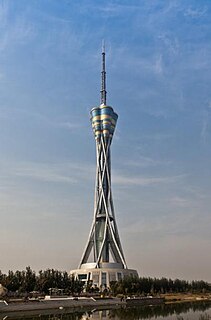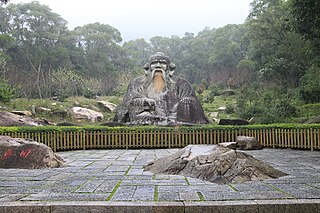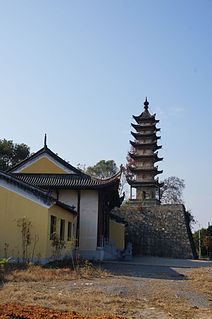The subgroups of the Han Chinese people, Chinese dialect groups or just dialect groups, are defined based on linguistic, cultural, ethnic, genetic and regional features. The terminology used in Mandarin to describe the groups is: "minxi", used in Mainland China or "zuqun", used in Taiwan. No Han subgroup is recognized as one of People's Republic of China's 56 official minority ethnic groups. Scholars like James W. Hayes have described the Han Chinese subgroups as "ethnic group" outright, at least in the context of Hong Kong society.

Zhongyuan, Chungyuan, or the Central Plain, also known as Zhongtu, Chungtu or Zhongzhou, Chungchou, is the area on the lower reaches of the Yellow River which formed the cradle of Chinese civilization. It forms part of the North China Plain.

The Seediq are a Taiwanese indigenous people who live primarily in Nantou County and Hualien County. Their language is also known as Seediq.

The Sui script or Shuishu, is a logographic writing system with some pictographic characters that can be used to write the Sui language. However, traditionally only shamans were familiar with the writing system, and it is not utilized for everyday use by ordinary Sui people. This system is used for geomancy and divination purposes. There are at least 500 different Sui characters, known as le1 sui3 in the Sui language. According to tradition, these characters were created by ljok8 to2 qong5. Some of these characters are pictoral representations, such as of a bird or a fish, and a few are schematic representations of a characteristic quality, such a snail represented by a drawing of an inward curving spiral. Many of these characters appear to be borrowings from Chinese characters and are written backwards, apparently for increased supernatural power.
Xiu Zelan, also written as Hsiu Tse-Lan, was a Taiwanese architect. Xue was born in Yuanling, Hunan. During World War II she attended the Architecture Department of National Central University in Chongqing. In 1947 she entered the Taiwan Rail Bureau. She took charge of the Department of General Logistics and Engineering as an assistant engineer. Her modernist interpretations of traditional motifs gained the attention of Chiang Kai-shek, and in 1965 she took charge of Yangmingshan's Chung-Shan Building project. Designed to house state ceremonies, the Chung-Shan Building brought Xiu acclaim and the project was subsequently considered to be one of her crowning achievements and earned the popular title "Number 1 Female Architect of Taiwan". Subsequently, on April 30, 1967, Xiu was awarded the first Golden Tripod Award for Architecture. In 2015, on the 50th anniversary of the Chung-Shan Building's completion, she was presented with a certificate of gratitude from the Taiwanese government.
Mu-chou Poo is a Taiwanese Egyptologist and scholar in Comparative Antiquity. Poo was born in Taiwan and obtained his undergraduate degree from National Taiwan University (1975). After receiving his PhD from The Johns Hopkins University (1984), he became a Research Fellow at the Institute of History and Philology at Academia Sinica (1983-2009). Currently, Poo teaches at the Chinese University of Hong Kong as a Professor of History.

Zhongyuan Tower, also known as Henan Radio and Television Tower, is located in Zhengzhou, China. It is a multi-functional commercial, artistic and cultural center integrating radio and television broadcasting, tourism, cross-border trade, cultural performance, catering and leisure. The tower measures 268 metres (879 ft) high and the top antenna is 120 metres (390 ft) high, with a total height of 388 metres (1,273 ft). It is the world's second tallest steel tower after the Tokyo Skytree.
I Lo-fen is a Taiwanese scholar and writer. She received her Chinese Literature Ph.D. from National Taiwan University. She has been an associate professor in the Division of Chinese in Nanyang Technological University’s School of Humanities and Social Sciences since July 2006, and was the Head of the Division (2014-2016). She had formerly committed in institutes like the National Taiwan University, Tamkang University, Fu Jen Catholic University, and the Institute of Chinese Literature and Philosophy at Academia Sinica. In addition, she was also a visiting professor at Stanford University in the United States and East Asian Institute at Sungkyunkwan University, South Korea. Her research expertise lies in Text and Image Studies, Su Shi studies, East Asian literature and intercultural exchanges in Classical Chinese, and Singapore literature, history, and arts studies. She is also a board member of the China Su Shi Studies Society, and an international board member of the Korea Society of East Asian Comparative Literature. She is the Founder and Honorary President of the "Text and Image Studies Society"(文图学会) that was official registered in Singapore on 18 December 2017. By integrating the history of Chinese literature and arts, she has accomplished a series of researches on poems in paintings and poetic imagery. She then proposed the idea of the “Text and Image Studies”(文图学) and focused on the relations, comparison and intertextuality between poems and paintings. From there, she has established her literary theory in arts creation and culture of aesthetics. She is also a column writer of Singapore Lianhe Zaobao (2007-), and she hosts podcast "Lofen says".

Literary Day is observed annually on May 4 in Taiwan, in honor of the May Fourth Movement. It was first celebrated on this day in 1945, and its establishment was affected by the dispute over whether the Kuomintang or the Communist Party was the legitimate successor to the May Fourth Movement, disagreements about how to interpret the movement, and other cultural struggles.
New Taipei City Constituency VIII includes most of Zhonghe in New Taipei City. The district was formerly known as Taipei County Constituency VIII (2008-2010) and was created in 2008, when all local constituencies of the Legislative Yuan were reorganized to become single-member districts.
Taoyuan City Constituency IV includes most of Taoyuan District in Taoyuan City. The district was formerly known as Taoyuan County Constituency IV (2008-2014) and was created in 2008, when all local constituencies of the Legislative Yuan were reorganized to become single-member districts.

Lingnan architecture, or Cantonese architecture, refers to the characteristic architectural style(s) of the Lingnan region – the Southern Chinese provinces of Guangdong and Guangxi. Usually, it is referring to the architecture associated with the Cantonese people, with other peoples in the area having their own styles. This style began with the architecture of the ancient non-Han Nanyue people and absorbed certain architectural elements from the Tang Empire and Song Empire as the region sinicized in the later half of the first millennium AD.

Huang Baoyu was a Taiwanese artist, calligrapher and architect, known for designing the National Palace Museum in Taipei, Taiwan. His design for the museum was chosen after the original competition winner, Wang Da-hong, refused to modify his design to comply with the government's wishes. Huang specialised in the traditional Chinese palace style, and was the favourite architect of former leader, Chiang Kai-shek.

Minnan culture or Hokkien/Hoklo culture, also considered as the Mainstream Southern Min Culture, refers to the culture of the Hoklo people, a group of Han Chinese people who have historically been the dominant demographic in the province of Fujian in Southern China, Taiwan, Singapore, and certain overseas Chinese communities in Southeast Asia.

Wuyue culture refers to the regional Chinese culture of the Wuyue people, a Han Chinese subgroup that has historically been the dominant demographic in the region of Jiangnan. Wuyue culture is characterized as being delicate, graceful and refined, having preserved many unique cultural traditions nonextant in other regions of China.

Hokkien architecture, also called Hoklo architecture or Minnan architecture, refers to the architectural style of the Hoklo people, the Han Chinese group who have historically been the dominant demographic of the Southern Chinese province of Fujian, Taiwan, and Singapore. This style shares many similarities with those of surrounding Han Chinese groups. There are, however, several features that are unique or mostly unique to Hoklo-made buildings, making many traditional buildings in Hokkien and Taiwan visually distinctive from those outside the region.

Tam Kung Temple is a Chinese temple located at Mile 1.5 of North Road in Sandakan, Sabah, Malaysia. The temple was established in 1894 by Hakka immigrants in Sandakan.

Philosophy in Taiwan is the set of philosophical traditions in Taiwan, while Taiwanese philosophy is taken to mean philosophical work from the country. Philosophical thought in Taiwan is diverse, drawing influence from Chinese philosophy during Qing rule from the 17th and 18th century, and Western philosophy through the Kyoto School during Japanese rule in the 19th and early 20th century. Taiwanese philosophy took a more endogenous turn during the modern era, with burgeoning philosophical debate regarding Taiwanese Gemeinschaft.
Fujianese organized crime or Fujiang gang refers to crime syndicates, similar to triad gangs, composed of Fujianese people. The term primarily refers to Fujianese immigrant gangs in Hong Kong, but can also refer more broadly to Fujianese community associations or to native crime syndicates in the province of Fujian.

The Fujian–Taiwan relations, also known as the Min–Tai relations, refers to the relationship between Fujian, which is located in mainland China, and Taiwan, which is across the Taiwan Strait. Since the average width of the Taiwan Strait is 180 kilometers, Fujian and Taiwan are adjacent, similar in both climate and environment. Although the relationship between Taiwan and Fujian has changed with the development of history, the two places have maintained close relations in terms of personnel, economy, military, culture and other aspects. At present, Taiwan residents are mostly descendants of immigrants from mainland China, of which the southern Fujian ethnic group is the main group, accounting for 73.5% of Taiwan's total population. In terms of culture, language, religion, and customs, Fujian and Taiwan also share similarities.












